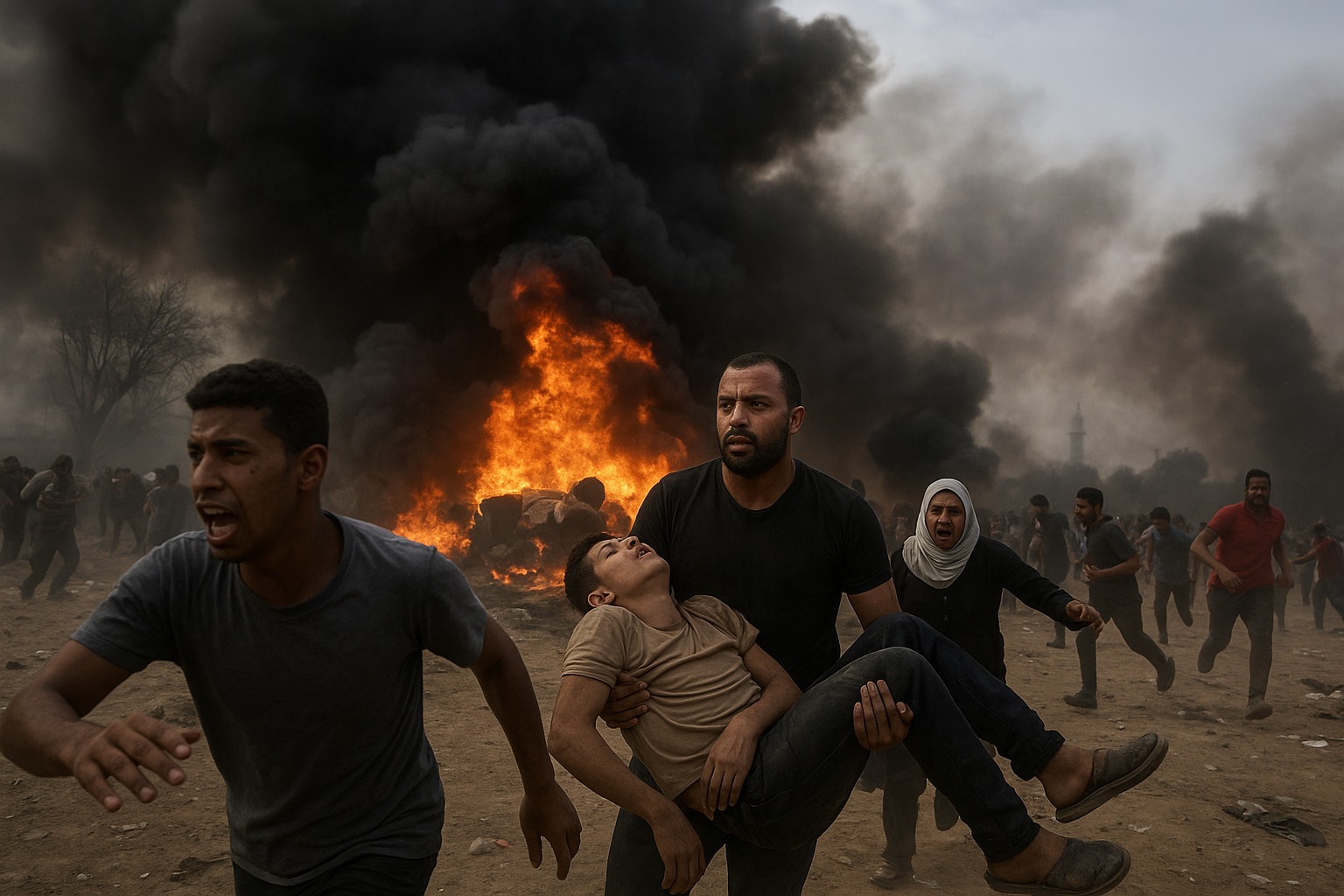In a tragic escalation of violence amid Gaza’s deepening humanitarian catastrophe, Israeli troops reportedly opened fire on Palestinians desperately seeking food from aid distribution centers, killing over 30 people on Saturday, July 19, 2025. The bloodshed unfolded in two separate incidents near distribution hubs run by the US- and Israeli-backed Gaza Humanitarian Foundation (GHF), triggering international outcry and further complicating already strained relief efforts in the war-torn enclave.
The deadliest episode unfolded in the Teina area, a desolate stretch of land located approximately three kilometers from one of the Gaza Humanitarian Foundation’s key aid distribution hubs on the eastern outskirts of Khan Younis. On Saturday morning, hundreds of Palestinians, driven by days of hunger and the hope of receiving rations, began marching toward the facility in anticipation of a food drop.
Eyewitnesses say the crowd—mostly comprised of young men but also including women and children—had barely covered half the distance when the atmosphere abruptly turned chaotic. According to survivors, Israeli forces stationed in the vicinity issued no audible warnings before gunfire rang out across the arid terrain. In a matter of seconds, what had begun as a desperate march for survival turned into a scene of horror, with bodies crumpling to the ground and panic spreading like wildfire.
“It was sudden and terrifying,” said Mahmoud Mokeimar, who was among the marchers. “There was no warning, no announcement. Just bullets cutting through the air. People were falling around me.” Mokeimar described scenes of utter panic, with people dropping their belongings and running in every direction to escape the gunfire.
Medical personnel from Nasser Hospital in Khan Younis later confirmed they had received 25 bodies from the Teina incident alone, along with dozens of severely wounded individuals, many with gunshot injuries to the chest and head. The hospital, already overwhelmed by weeks of war-related casualties, scrambled to provide emergency care with dwindling supplies and overstretched staff.
The Israeli military has not released a detailed account of its actions in Teina, but in previous statements regarding similar incidents, it has maintained that any fire was meant as a “warning” to prevent crowding near security perimeters. However, survivors and human rights observers argue that the location—several kilometers away from the nearest aid hub—suggests that the crowd posed no immediate threat to the distribution center or any military position.
Local officials and humanitarian groups say the killings at Teina highlight a disturbing pattern of excessive force being used against unarmed civilians attempting to access basic necessities. As famine looms over Gaza and desperation grows, scenes like the one in Teina reflect a harrowing new reality—where even the journey toward aid can prove fatal.
This marks one of the deadliest days at humanitarian sites since the GHF began operations in May 2024 with support from the U.S. and Israeli governments. The organization was established as an alternative to the United Nations-led aid system, which both Washington and Tel Aviv have accused of inadvertently supplying Hamas — claims the UN strongly denies.
While the GHF maintains that no fatalities have occurred within its secured premises and attributes a recent death toll of 30 people to a stampede, local officials and rights groups contest this version of events. Witnesses allege that armed guards employed by the GHF and distant Israeli military positions have routinely used lethal force against civilians attempting to access aid.
The Israeli military has repeatedly emphasized in its public briefings that it does not maintain a permanent or direct presence inside humanitarian aid distribution centers, asserting instead that its role is limited to providing what it calls “perimeter security” around such sites. According to the army, its standard operating procedure involves the use of warning fire—such as shots into the air or nearby ground—when large groups of civilians are perceived to be moving too close to sensitive areas or security cordons. While this has been presented as a precautionary measure aimed at preventing what the military describes as potential disorder or risks to its personnel, the practice has been a source of mounting concern among humanitarian organizations and rights groups, who argue it creates an atmosphere of fear and endangers civilians already struggling with dire shortages of food and aid. Despite these ongoing controversies, the army has so far refrained from issuing any formal statement or clarification regarding the specific incidents reported on Saturday, leaving significant questions unanswered about what exactly transpired and under what rules of engagement.
In a brief and unsubstantiated statement, the GHF suggested that Hamas-affiliated agitators may have incited panic within the crowd, contributing to the stampede and violence. No evidence has been provided to support this assertion, and both the GHF and Israeli officials remained silent in the aftermath of the latest casualties.
Since the start of the Israel-Hamas conflict, efforts to distribute humanitarian aid have become increasingly militarized and dangerous, with multiple reports of civilians being shot at while attempting to collect food or water. Despite GHF’s claim of having delivered millions of meals through its four aid hubs — three of which are in southern Gaza — the growing desperation among Gaza’s 2.3 million residents has led to fatal confrontations as supplies dwindle and hunger intensifies.
Human rights organizations have sharply denounced the latest surge in violence, warning that the repeated targeting of aid-seeking civilians risks deepening what they describe as an already catastrophic humanitarian emergency. These groups have called not only for accountability through credible and independent investigations, but also for an urgent reassertion of international responsibility to ensure that humanitarian relief is delivered under neutral, UN-coordinated mechanisms free from political interference. Their statements stress that without such guarantees, aid efforts will remain vulnerable to manipulation, obstruction, or collapse altogether.
Meanwhile, for the people of Gaza, the crisis has reached a devastating convergence of forces: relentless military firepower, entrenched political distrust on all sides, and an ever-worsening scarcity of food, medicine, and basic survival necessities. Families are left to navigate dangerous aid queues under the shadow of gunfire, uncertain whether they will return home with bread or become the next victims of violence. The international appeals for de-escalation and sustained humanitarian corridors have so far yielded little tangible relief, leaving civilians trapped in an environment where desperation grows daily and the prospect of safety, stability, or even consistent access to aid remains bleakly out of reach.

